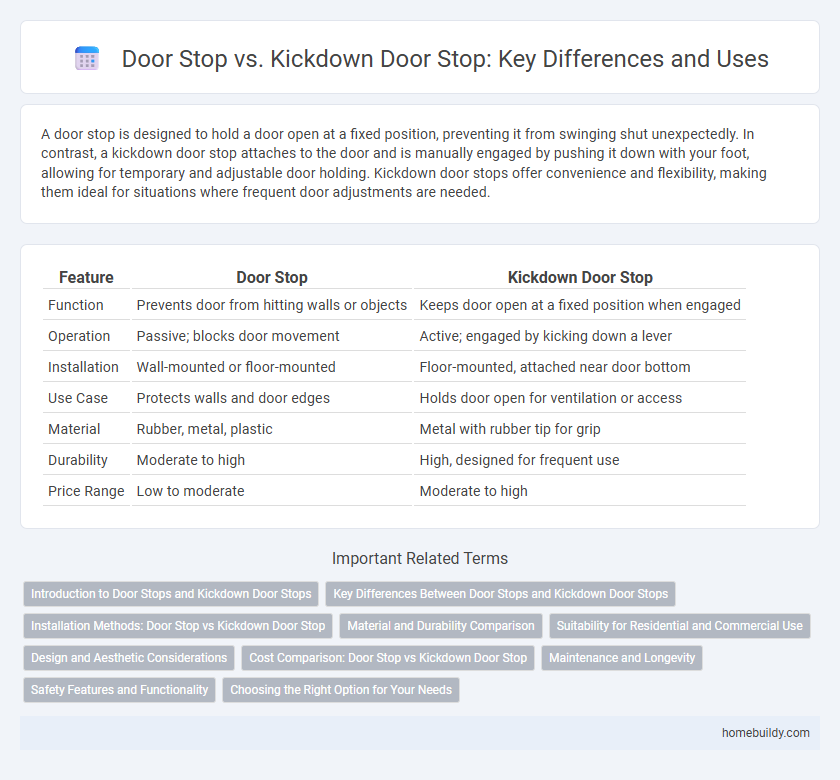A door stop is designed to hold a door open at a fixed position, preventing it from swinging shut unexpectedly. In contrast, a kickdown door stop attaches to the door and is manually engaged by pushing it down with your foot, allowing for temporary and adjustable door holding. Kickdown door stops offer convenience and flexibility, making them ideal for situations where frequent door adjustments are needed.
Table of Comparison
| Feature | Door Stop | Kickdown Door Stop |
|---|---|---|
| Function | Prevents door from hitting walls or objects | Keeps door open at a fixed position when engaged |
| Operation | Passive; blocks door movement | Active; engaged by kicking down a lever |
| Installation | Wall-mounted or floor-mounted | Floor-mounted, attached near door bottom |
| Use Case | Protects walls and door edges | Holds door open for ventilation or access |
| Material | Rubber, metal, plastic | Metal with rubber tip for grip |
| Durability | Moderate to high | High, designed for frequent use |
| Price Range | Low to moderate | Moderate to high |
Introduction to Door Stops and Kickdown Door Stops
Door stops are essential hardware that prevent doors from damaging walls or themselves by limiting door movement. Kickdown door stops differ by featuring a lever mechanism that allows users to secure the door in an open position easily. These versatile devices are ideal for controlling airflow, accessibility, and preventing unwanted door closures in high-traffic areas.
Key Differences Between Door Stops and Kickdown Door Stops
Door stops are typically fixed devices mounted to prevent doors from damaging walls by restricting their swing range, whereas kickdown door stops feature a lever mechanism that can be engaged or disengaged using the foot to hold a door open temporarily. Unlike standard door stops, kickdown models offer versatility in controlling door position for ventilation or accessibility, making them suitable for both residential and commercial settings. Material durability and installation type also differ, with kickdown door stops often constructed from metal for enhanced strength and installed on the door rather than the floor or wall.
Installation Methods: Door Stop vs Kickdown Door Stop
Surface-mounted door stops are installed by securing them to the baseboard or floor near the door, requiring minimal tools and typically involving screws or adhesive pads. Kickdown door stops attach directly to the bottom of the door with screws, allowing manual engagement and disengagement to hold the door open when needed. Installation of kickdown stops demands precise alignment to ensure proper function, whereas traditional door stops offer a simpler, fixed solution that prevents door damage without adjustable control.
Material and Durability Comparison
Door stops are often made from rubber, plastic, or metal, offering moderate durability and effective protection against door damage. Kickdown door stops typically feature heavy-duty metal construction, such as stainless steel or brass, ensuring enhanced durability and long-lasting performance under frequent use. Compared to standard door stops, kickdown models provide superior material strength and resistance to wear, making them ideal for high-traffic areas.
Suitability for Residential and Commercial Use
Door stops provide a simple solution for preventing door damage in both residential and commercial settings, typically featuring a compact design ideal for indoor use. Kickdown door stops offer enhanced durability and functionality, making them suitable for high-traffic commercial environments where doors need to be held open securely and frequently. Residential spaces benefit from traditional door stops due to their unobtrusive appearance, while commercial properties rely on kickdown door stops for their robust construction and ease of operation.
Design and Aesthetic Considerations
Door stops are typically compact and discreet, designed to blend seamlessly with various interior styles, while kickdown door stops feature a functional lever that folds up or down, often making them more noticeable but highly practical. The sleek design of standard door stops complements minimalist aesthetic preferences without drawing attention, whereas kickdown models offer a utilitarian look suited for industrial or high-traffic settings. Material choices like brass, stainless steel, or rubber further influence the visual appeal and integration of each type within home or commercial decor.
Cost Comparison: Door Stop vs Kickdown Door Stop
Standard door stops typically cost between $5 and $15, making them an affordable solution for preventing door damage and maintaining wall integrity. Kickdown door stops, priced around $10 to $25, offer enhanced functionality by allowing doors to be held open at various angles, justifying their higher cost with added convenience. When comparing expenses, door stops provide budget-friendly protection, while kickdown door stops deliver greater versatility worth the additional investment.
Maintenance and Longevity
Door stops generally require minimal maintenance, with occasional cleaning to prevent dust buildup and simple tightening of screws to ensure stability, which contributes to their long lifespan. Kickdown door stops, featuring a movable arm that locks the door in place, demand more regular inspection and lubrication of the hinge mechanism to prevent wear and ensure smooth operation. Proper upkeep of kickdown door stops extends their durability and functionality, making them a reliable choice for high-traffic areas where frequent door holding is needed.
Safety Features and Functionality
Door stops provide basic protection by preventing doors from swinging too far, reducing wall and door damage, while kickdown door stops offer enhanced safety by securely holding doors open at adjustable angles to prevent accidental closures and potential injuries. The kickdown mechanism allows for hands-free operation and improved stability, making it ideal for high-traffic areas or environments requiring controlled access. Both options contribute to safety, but kickdown door stops deliver superior functionality through adjustable positioning and increased durability.
Choosing the Right Option for Your Needs
Door stops prevent damage to walls and doors by absorbing impact and holding doors open securely. Kickdown door stops offer adjustable, hands-free operation ideal for high-traffic areas, while traditional door stops provide simple, stationary protection suitable for residential use. Selecting the right option depends on factors like frequency of use, convenience, and desired door positioning control.
door stop vs kickdown door stop Infographic

 homebuildy.com
homebuildy.com